Discover Florida Nature
It's time to explore the natural Florida


|
|
|
|
|
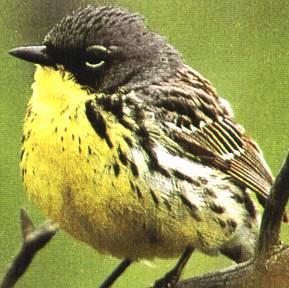 Kirtland’s
Warbler
(Dendroica kirtlandii) Endangered- The endangered Kirtland's warbler is
one of the rarest members of the wood warbler (Parulidae) family. It is
a bird of unusual interest for many reasons. It nests in just a few
counties in Michigan's northern Lower and Upper peninsulas, in Wisconsin
and the province of Ontario and, currently, nowhere else on Earth. The
male Kirtland's warblers' summer plumage is composed of a distinctive
bright yellow colored breast streaked in black and bluish gray back
feathers, a dark mask over its face with white eye rings, and bobbing
tail. The female's plumage coloration is less bright; her facial area is
devoid of a mask. Overall length of the bird is less than six inches.
The diet of the warbler includes many different insect species at
various developmental stages, including caterpillars, butterflies,
moths, flies, grasshoppers, as well as ripe blueberries, when in season.
The winter range of the Kirtland's warbler include the Bahamas and parts
of key West. Kirtland’s
Warbler
(Dendroica kirtlandii) Endangered- The endangered Kirtland's warbler is
one of the rarest members of the wood warbler (Parulidae) family. It is
a bird of unusual interest for many reasons. It nests in just a few
counties in Michigan's northern Lower and Upper peninsulas, in Wisconsin
and the province of Ontario and, currently, nowhere else on Earth. The
male Kirtland's warblers' summer plumage is composed of a distinctive
bright yellow colored breast streaked in black and bluish gray back
feathers, a dark mask over its face with white eye rings, and bobbing
tail. The female's plumage coloration is less bright; her facial area is
devoid of a mask. Overall length of the bird is less than six inches.
The diet of the warbler includes many different insect species at
various developmental stages, including caterpillars, butterflies,
moths, flies, grasshoppers, as well as ripe blueberries, when in season.
The winter range of the Kirtland's warbler include the Bahamas and parts
of key West. 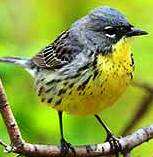 Bachman’s
Warbler
(Vermivora bachmanii) Endangered- The Bachman's Warbler is
one of the smallest warblers, the total length is between 4 to 4 and 1/2
inches. The male is olive green above, face and underparts yellow,
throat patch and crown patch black. The female does not have the black
throat; the upper parts are olive green, the forehead and underparts
yellow, and the is crown grayish. Although little information is
available on food habits, it is suspected Bachman's warblers eat insects
and possibly ants. Nesting has been recorded from late March to early
June, with clutch size usually being three or four eggs, but
occasionally five. The birds begin migrating southward during July and
apparently pass through Key West by early September. The Bachman's
warbler breeds in the Southeastern United States and winters in western
Cuba and the Isle of Pines. Bachman’s
Warbler
(Vermivora bachmanii) Endangered- The Bachman's Warbler is
one of the smallest warblers, the total length is between 4 to 4 and 1/2
inches. The male is olive green above, face and underparts yellow,
throat patch and crown patch black. The female does not have the black
throat; the upper parts are olive green, the forehead and underparts
yellow, and the is crown grayish. Although little information is
available on food habits, it is suspected Bachman's warblers eat insects
and possibly ants. Nesting has been recorded from late March to early
June, with clutch size usually being three or four eggs, but
occasionally five. The birds begin migrating southward during July and
apparently pass through Key West by early September. The Bachman's
warbler breeds in the Southeastern United States and winters in western
Cuba and the Isle of Pines.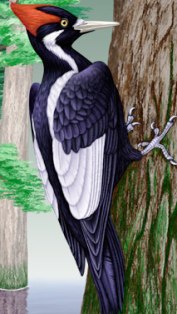 Ivory-Billed
Woodpecker
(Campephilus principalis) Endangered- The ivory-billed
woodpecker is among the world’s largest woodpeckers. Only the imperial
woodpecker of Mexico, now thought by many to be extinct, was larger than
the ivory-bill. Averaging about 20 inches in length, the ivory billed
woodpecker is frequently mistaken for the smaller but similarly marked
pileated woodpecker. Beetle larvae are the primary food source for
ivory-bills, which are often the first woodpeckers on dying trees
searching for these larvae. Ivory-bills are believed to mate for life.
They share the duties of incubating their china-white eggs and raising
their young. Stiff wing feathers make the ivory-bill an especially loud
flyer! Ivory-Billed
Woodpecker
(Campephilus principalis) Endangered- The ivory-billed
woodpecker is among the world’s largest woodpeckers. Only the imperial
woodpecker of Mexico, now thought by many to be extinct, was larger than
the ivory-bill. Averaging about 20 inches in length, the ivory billed
woodpecker is frequently mistaken for the smaller but similarly marked
pileated woodpecker. Beetle larvae are the primary food source for
ivory-bills, which are often the first woodpeckers on dying trees
searching for these larvae. Ivory-bills are believed to mate for life.
They share the duties of incubating their china-white eggs and raising
their young. Stiff wing feathers make the ivory-bill an especially loud
flyer!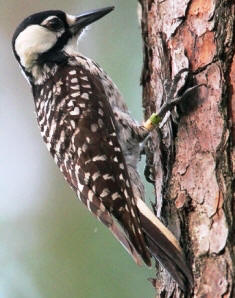 Red-Cockaded
Woodpecker (Picoides borealis) SSC- The red-cockaded woodpecker
is 7-8 inches long with a wing span of 16 to 18 inches. There are black
and white horizontal stripes on its back, and its cheeks and underparts
are white. Its flanks are black streaked. The cap and stripe on the side
of the neck and the throat are black. The male has a small red spot on
each side of the black cap. After the first post fledgling molt,
fledgling males have a red crown patch. This woodpecker's diet is
composed mainly of insects which include ants, beetles, wood-boring
insects, caterpillars, and corn ear worms if available. About 16 to 18
percent of the diet includes seasonal wild fruit. This bird's range is
closely tied to the distribution of southern pines. Historically, the
red-cockaded woodpecker occurred from East Texas and Oklahoma, to
Florida, and North to New Jersey. The present distribution is similar,
except the species has been extirpated from Missouri, Maryland, and New
Jersey. Red-cockaded woodpeckers need live, large older pines in which
to excavate their cavities. Red-Cockaded
Woodpecker (Picoides borealis) SSC- The red-cockaded woodpecker
is 7-8 inches long with a wing span of 16 to 18 inches. There are black
and white horizontal stripes on its back, and its cheeks and underparts
are white. Its flanks are black streaked. The cap and stripe on the side
of the neck and the throat are black. The male has a small red spot on
each side of the black cap. After the first post fledgling molt,
fledgling males have a red crown patch. This woodpecker's diet is
composed mainly of insects which include ants, beetles, wood-boring
insects, caterpillars, and corn ear worms if available. About 16 to 18
percent of the diet includes seasonal wild fruit. This bird's range is
closely tied to the distribution of southern pines. Historically, the
red-cockaded woodpecker occurred from East Texas and Oklahoma, to
Florida, and North to New Jersey. The present distribution is similar,
except the species has been extirpated from Missouri, Maryland, and New
Jersey. Red-cockaded woodpeckers need live, large older pines in which
to excavate their cavities.
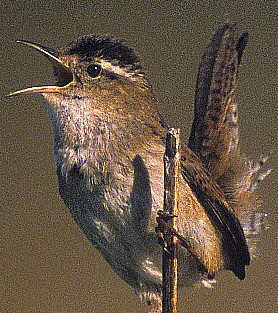 Marian’s
Marsh Wren
(Cistothorus palustris marianae) SSC- All marsh wrens are small wrens
with a prominent white stripe above the eye. Marian’s marsh wren has a
dark cinnamon-brown head, neck, and upper back; dark brown wings, rump,
tail, and lower back; and underparts shaded with brown. Marian's marsh
wrens are found on the gulf coast of Florida from Pasco to Santa Rosa
County. This bird inhabits black needlerush and prefers taller
vegetation found along tidal creeks. Marsh wrens are uncommon and sue to
loss of the habitat are currently a bird of special concern in Florida Marian’s
Marsh Wren
(Cistothorus palustris marianae) SSC- All marsh wrens are small wrens
with a prominent white stripe above the eye. Marian’s marsh wren has a
dark cinnamon-brown head, neck, and upper back; dark brown wings, rump,
tail, and lower back; and underparts shaded with brown. Marian's marsh
wrens are found on the gulf coast of Florida from Pasco to Santa Rosa
County. This bird inhabits black needlerush and prefers taller
vegetation found along tidal creeks. Marsh wrens are uncommon and sue to
loss of the habitat are currently a bird of special concern in Florida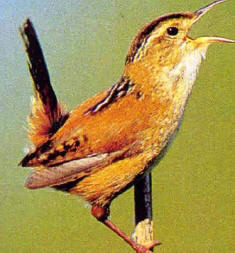 Worthington’s
Marsh Wren
(Cistothorus palustris griseus) SSC- Marsh Wrens are
ubiquitous in marshes along most of the coastline of the United States
and southern Canada as well as many inland marshes. The behaviors of
these wrens have fascinated ornithologists, the males build multiple
nests for prospective mates to choose among and, they destroy the eggs
and nests of other species and other Marsh Wrens. All marsh wrens are
small wrens with a prominent white stripe above the eye. Worthingtons
marsh wren is grayer overall than Marian's marsh wren. This subspecies
of the marsh wren has grayish-brown upperparts and pale grayish
underparts. Worthington's marsh wrens inhabit the
Atlantic coast of Florida from Nassau County to the St. Johns River,
in tidal marshes dominated by smooth cordgrass. Worthington’s
Marsh Wren
(Cistothorus palustris griseus) SSC- Marsh Wrens are
ubiquitous in marshes along most of the coastline of the United States
and southern Canada as well as many inland marshes. The behaviors of
these wrens have fascinated ornithologists, the males build multiple
nests for prospective mates to choose among and, they destroy the eggs
and nests of other species and other Marsh Wrens. All marsh wrens are
small wrens with a prominent white stripe above the eye. Worthingtons
marsh wren is grayer overall than Marian's marsh wren. This subspecies
of the marsh wren has grayish-brown upperparts and pale grayish
underparts. Worthington's marsh wrens inhabit the
Atlantic coast of Florida from Nassau County to the St. Johns River,
in tidal marshes dominated by smooth cordgrass.
|
|
|
Advertise | Privacy Statement | Dog Encyclopedia | Video |Contact | Alaska Nature |
|